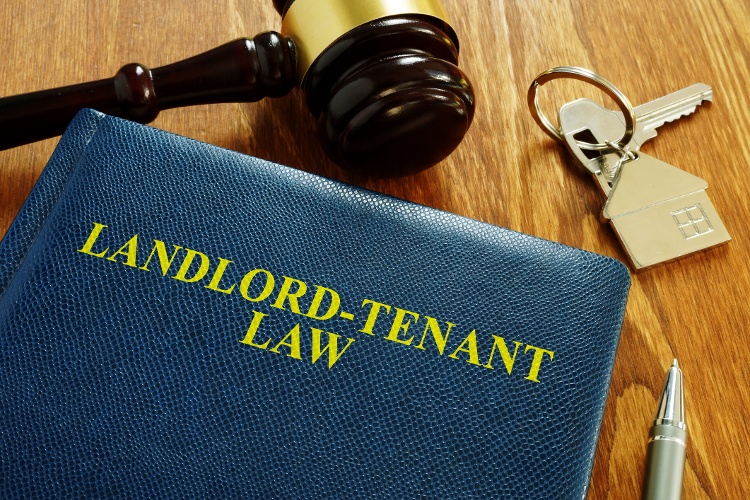Can Landloard Repair Roof Without Noticeo
Last updated on October iv, 2022
Randy owns a unmarried-family rental property in San Antonio. When his tenants first moved in, he walked the tenants through the holding every bit part of the move-in inspection, explained to the tenants their responsibility for keeping the dwelling in good status, and took photos of places where the carpet was beginning to show signs of vesture and tear. Even though the tenants had a great credit score and rental history written report, when the tenants moved out in that location was a burn mark on the carpet and a large visible wine stain from last New year's day's Eve. Although Randy screened the tenants thoroughly and set the right expectations with the tenants when they moved in, accidents practice happen. Carpets toll a lot of money to replace and at present Randy wants to collect the toll of replacing the carpet from the tenant. But fifty-fifty though he wants to charge the tenants, is he legally entitled to do and so? Go along reading to acquire when a landlord typically can and can't charge for carpet replacement, and how to potentially use the tenant'south security deposit to pay for the price of replacing a carpet. Co-ordinate to the Legal Information Plant at Cornell Law Schoolhouse, under the Implied Warranty of Habitability, landlords must keep the property habitable even if the lease doesn't require specific repairs. In guild to make information technology easier for tenants to go landlords to make repairs, the warranty makes the tenant's duty to pay rent conditional on the landlord's duty to maintain a habitable living space. So, while a landlord does not have to replace carpeting, the responsibleness for doing so depends on three factors: However, even if a landlord has to replace carpet, that doesn't necessarily hateful the landlord has to pay for the carpet replacement. The price of rug replacement runs between $2 to $eight per square foot installed, as of this writing (June 2022). Replacing the carpet in a 1,500 square-pes rental abode would average $seven,500. Depending on your gross rental income, y'all could have negative cash menstruation for 6 months or more considering of the carpeting replacement expense. That's why landlords charge the tenant for rug replacement if they possibly can. Now, let's hash out when a landlord can not charge for replacing the carpet, and when the landlord might be able to recover all or part of the cost of carpet replacement from the tenant. A landlord tin can't make a tenant pay for replacing items that wear out due to normal wear and tear. The concept of "wear and tear" is based on the "useful life" rule. The rule states that assets such as a refrigerator, stove, dishwasher, pigment, window coverings, and carpet only terminal for and so long. Examples of normal article of clothing and tear How long does carpet last? IRS Publication 527 states that carpet in a residential rental property wears out after five years, at least for tax purposes, based on the full general depreciation system. That doesn't mean the carpet has to be replaced every five years. But, the depreciation period for carpet does provide a guideline of what carpet normal wear and tear would be. When a landlord has to pay Assume a tenant moves in when the carpet is v years old and moves out 2 years later on. There's a burn mark caused by a fallen candle where the living room sofa used to exist, and the carpet also has red wine stains in the center of the room. Considering of the historic period of the carpeting, a landlord would have to pay for the carpet replacement even though the harm to the rug is arguably beyond normal wear and tear. Now let's look at the same scenario with a slightly different timeframe. If the tenant moved in when the rug was three years old and moved out one year later, the landlord could charge the tenant for the remaining one year of useful carpet life. If the original cost of the living room carpet was $one,200 the tenant could be liable for $240 in carpet damage. Using a pro-rata charge is one of the most common and fairest ways to collect money from the tenant for carpet damage beyond normal habiliment and tear. Imagine if a landlord charged the tenant for the entire replacement amount of $i,200 and the tenant hired a lawyer and took the landlord to court. The tenant'south lawyer would argue that fifty-fifty though the landlord has benefited by deducting the carpeting depreciation from his taxes each year, the landlord still wants the tenant to pay for the unabridged replacement corporeality. That's plainly unfair - and a estimate would likely hold - even in states that are very landlord-friendly. Depending on the state landlord-tenant law, the landlord could be held liable for double or triple damages for misusing the tenant'southward security deposit to pay for the entire cost of replacing the carpet. If the carpet needs to exist replaced due to damage caused by the tenant beyond normal wear and tear, a landlord can withhold all or office of the security deposit. Be sure to double-check with your local existent manor chaser and landlord-tenant laws, then follow these steps: A landlord should take photos of the status of the belongings during the movement-in inspection, regular routine property inspections, and during the move-out inspection. These pictures will serve as prove of existing wear-and-tear and serve equally proof that unusual damages to the carpet such as fire marks, oil stains, or pet urine were caused past the tenant. Suppose the tenant caused irreparable damage to a four-year-former carpet with a useful life of five years. If the rug originally toll $3,000, the tenant's pro-rata share for the remaining one year of useful rug life would be $600 ($3,000 original price / 5-year useful life). Note that the cost of carpet impairment is based on the original toll of the carpet, not what the new carpet would toll. That's because the tenant is being charged for the remaining value of the carpet if the tenant had not irreparably damaged the carpet. Notify the tenant that part of their security deposit is being withheld due to damage to the carpet beyond normal wear and tear. Notification needs to take place before the fourth dimension to refund the tenant's security deposit has expired, ordinarily 14 days afterward the charter ends and the tenant moves out. The letter of the alphabet from the landlord to tenant for the cost of rug damage beingness withheld from the security deposit should include: Many local real estate attorneys specializing in residential landlord-tenant constabulary offer free notice forms on their websites. You can likewise download a costless 'Letter to Tenant for Damages' from TurboTenant, ezLandlordForms, and the LawDepot. Routine carpet cleaning is mostly the landlord's responsibility and one of the expenses of owning and operating a rental property. What if the lease agreement states that the tenant has to pay for routine carpeting cleaning? Country landlord-tenant constabulary may prohibit a landlord from deducting routine carpet cleaning from the tenant'southward security deposit. To recover the cost of rug cleaning that the tenant agreed to, the landlord would have to take the tenant to small claims court. Landlords clean the carpet in between tenant turns and sometimes use rug cleaning as an incentive for the tenant to extend the lease for another year. Compared to replacing the entire carpeting, carpet cleaning is relatively inexpensive and may even extend the life of the carpeting. In other words, suing a tenant in pocket-sized claims court for the small toll of carpet cleaning probably isn't worth the time and try, even if a landlord tin can exercise so. Whether or not a landlord can charge for carpeting replacement depends on important concepts such equally normal habiliment and tear, useful life, and unusual harm caused past the tenant. In some cases, a landlord can use all or part of the tenant's security deposit to pay for carpet damage acquired by the tenant, while in other cases the landlord is out of luck. Depending on the state of affairs, a landlord and tenant may agree to share function of the cost of replacing the carpet, helping to go along repair costs lower and returns higher for a rental property investor.
Does a landlord take to supplant the carpet?
Who pays for replacing the carpet?

What is normal wear and tear for carpets?

How to charge a tenant for carpet replacement
How to use a security eolith for carpet replacement
Pace #1: Take photos
Step #2: Calculate actual cost of carpet damage
Pace #3: Notify the tenant
Tin can a landlord charge for routine carpet cleaning?
Last thoughts on this topic

Source: https://learn.roofstock.com/blog/can-landlord-charge-for-carpet-replacement
Posted by: ewingshoseathe1939.blogspot.com


0 Response to "Can Landloard Repair Roof Without Noticeo"
Post a Comment